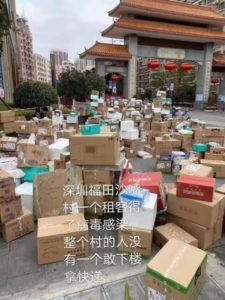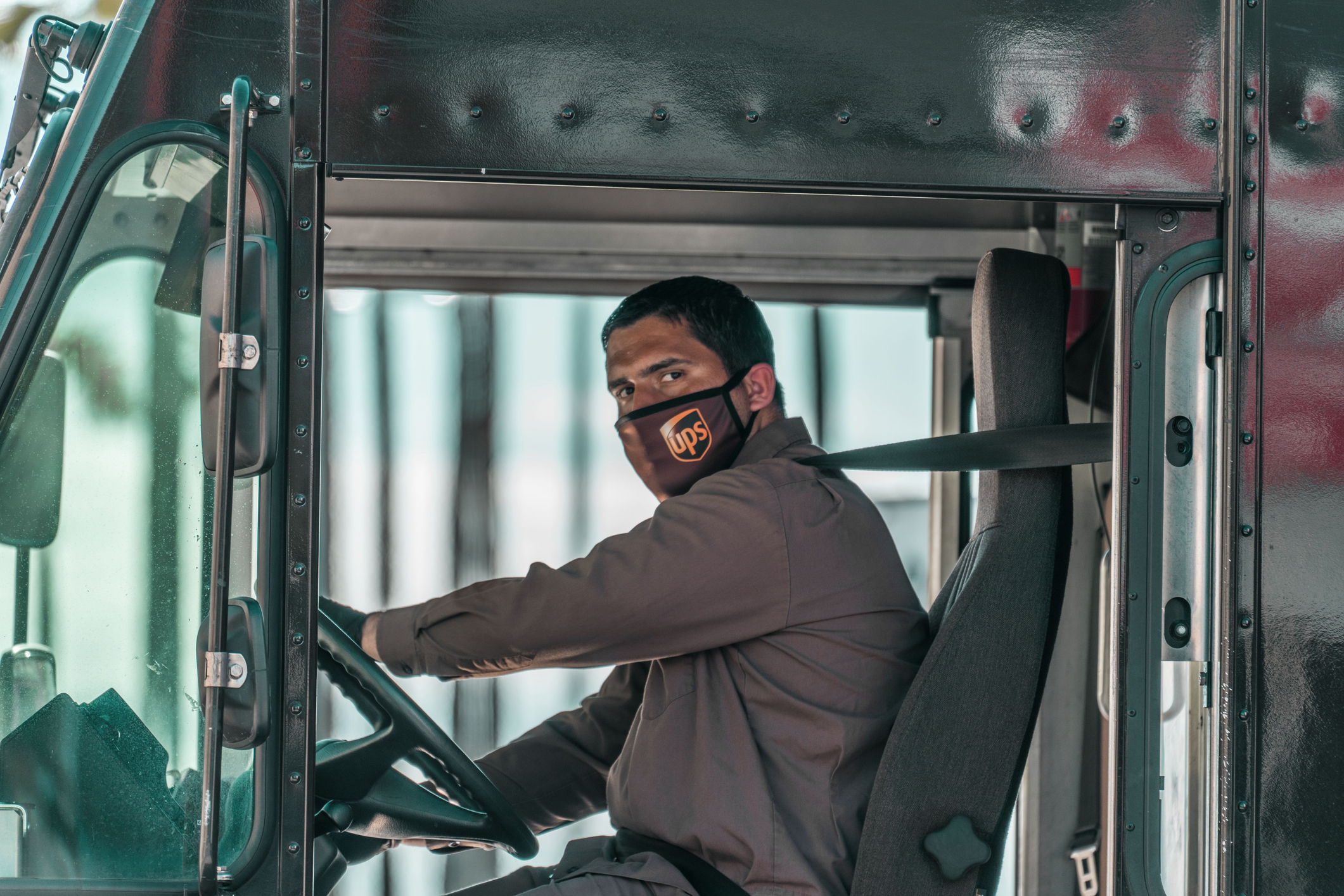This blog is part of the COMPAS Coronavirus and Mobility Forum.
Read Part I of this blog here.
After lockdowns were enforced in mainland China, many industries went into temporary closure, causing significant distress especially to day laborers, small business owners, and other economically vulnerable populations in urban areas who subsist on small, immediate income (see Xiang 2020, Ma 2020, Xing 2020). Meanwhile, certain occupations that had carried little-to-no social prestige or respect, like community gatekeeper (bao’an) and deliverer (kuaidi), emerged to take prominence. In fact, the logistics and delivery sector was one of the first fully reinstated industries in China after the sweeping economic halt in late January. Although deliverers were hailed on Chinese social media for continuing their services, their bodily movements and contacts gave rise to a new set of concerns: Do deliverers and the boxes they handle carry the disease?

From Chinese social media in February, 2020. The unverifiable caption reads: “A tenant in a Shenzhen village was confirmed with the disease. The whole village does not dare come downstairs to get their deliveries.”
New Rituals For/Against the Vulnerable
In response to this concern, both service providers and consumers adopted new rituals to manage both human encounters and package handling. Deliverers were no longer welcome to step onto community ground or into personal living spaces. Only the packages were to enter beyond the bars and gates guarded by security persons. However, even those packaged items could enter only by following protocols that dictated time, space, and human contact with objects (e.g. the guidelines from the Chinese National Health Commission.) As a potential carrier of disease, the deliverer slides back into the realm of invisibility. The packages and potential virus they carry are the scant remaining evidence that reminds us of the human bodies and labor that are required in moving those goods.
Even though many governments sealed their borders to travellers, there were efforts to ensure that goods continued to circulate. While we find restrictions on bodily movements distressful, we would have found restrictions on the circulation of goods even more intolerable (see Neilson 2020). Yet, supply chains cannot operate without human labour, and they are run by people like truck drivers, deliverers, grocery clerks, and factory workers, all of whom have been deemed most vulnerable to the recent developments in technology. As potentially replaceable parts in the giant logistics scheme, vulnerable human bodies emerge as both the absolute necessity and the biggest threat in maintaining a disease-ridden society. And because the situation appears so dire, these bodies become excused from both the restriction of movements and the political discourse. After all, capitalism is the order of the day, in China and the world beyond.
Politics of Movement in the Postcolonial World of COVID-19
When the disease eventually gaining the official title of “pandemic,” it resulted not only in shortages of face masks on the production end, but also undelivered boxes of face masks stranded and backlogged in storage areas around the world. Adding to the pressure, border closures and export restrictions on protective gear made it even more difficult to fulfill the orders.
Under these extreme circumstances, China’s gifting of face masks, packaged in made-in-China boxes, has gained significant presence around the globe. Similar gestures have been made by other governments like South Korea and Taiwan, which have supposedly weathered the disease “ahead of time”. Unlike the donated face masks that I mention in Part I that literally toured Northeast Asia, face masks have now become an even more conspicuous form of gift, with less clarity on what form of returns should take place.
In addition to being a sign of care, mask-giftings have been mediatized to index the sending government’s competence in handling the disease.
Ironically, this involves a partial erasure of the capitalist order that placed mask manufacturing powerhouses in certain regions. In any case, mask-gifting resulted in mounting suspicion especially against China, a geographically, politically, and culturally distant polity that had encroached upon the humanitarian gift-giving practices reserved for the altruistic, democratic, responsible, [fill-in-the-blank], “West” (Ticktin 2017).
Suspicion, however, does not go just one way. While sending out locally manufactured masks all over the world, postcolonial subjects in East Asia are increasingly scrutinizing the value of the “West.” Crudely put, COVID-19 has turned into a sign of “Western” incompetence. The inquiry itself is by no means novel; in the recent past, Asian governments have assembled similar postcolonial question with a strong tinge of nationalism, while assuring that such assemblies enable each country to thrive in the global capitalist market order (Ong 1999). Rather than novelty, what matters is that this scepticism in-the-making can shape the movements of goods and persons by reconfiguring the field of political and cultural values.
Moreover, the scope of change is not necessarily limited to masks, boxes, and “essential workers”. Consider a text message from my Chinese friend: “I was going to send my child to study abroad when he grows up, but given this condition of pandemic, I really have no confidence in sending him off.”
Clearly, COVID-19 is signaling a much broader reassessment of narratives of current and future movement—a change already emerging in some people’s imagined horizons of the post-pandemic world.
Do Dom Kim is a PhD Candidate in Anthropology at the University of Chicago
References
Ong, Aihwa. 1999. Flexible Citizenship: The Cultural Logics of Transnationality. Durham: Duke University Press.
Ticktin, Miriam. 2017. “A World without Innocence”. American Ethnologist 44(4), 577-590.
Treichler, Paula A. 1987, AIDS, Homophobia, and Biomedical Discourse: An Epidemic of Signification. AIDS: Cultural Analysis/Cultural Activism: 31-70.
